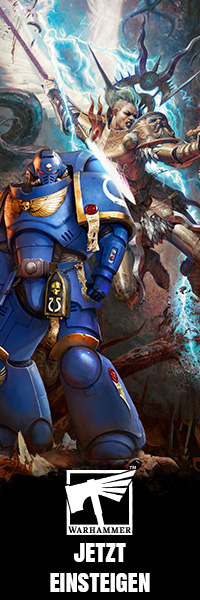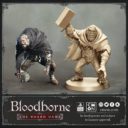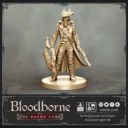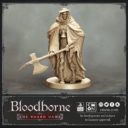CMON: Weitere Bloodborne Previews
Es gibt mehr Informationen und Bilder zum kommenden Brettspiel Bloodborne von CoolMiniOrNot, darunter ikonische Gegner und ein Jäger.
Plaguing the town of Yharnam is the Huntsman’s Minion, and he’s ready to tarnish anyone who comes their way. Will you be the Hunter or the hunted…? Coming soon to Kickstarter Bloodborne: The Board Game!
A wretched disease is spreading around the city of Yharnam, where monstrous brutes roam the dark streets and kill anyone who comes their way… Join the Hunters and fight against the terror that is infesting the city! Bloodborne: The Board Game is coming soon to Kickstarter!
As their bells ring with each step, they’ll slowly approach you with their axes tainted in blood. Are you willing to face the Church Giants? Coming soon to Kickstarter Bloodborne: The Board Game!
Und im zweiten Teil des Design-Tagebuchs wird auf die Spielmechanik, speziell Karten, Kampf und Deckbau eingegangen.
Design Diary (Part 2): Cards, Combat, and Deckbuilding
A key component of the Bloodborne video game is how you manage your stats. They determine which weapons you can use, how powerful said weapons will be, and manage your Hit Points, Stamina, and… Bloodtinge (don’t worry, if you don’t know that last one, it’s fine). When leveling up, it’s a careful balancing act of choosing between dealing more damage and upping your overall survivability.
This degree of customization and progression, of course, had to make it into Bloodborne: The Board Game.
Before we eventually settled on the deckbuilding aspect, we tested many different variations of utilizing cards as your overall resource. Versions where you had a set hand of actions (effectively becoming a Hand-Building versions), an Action Board sort of system, and probably more that I can’t even remember at this time. Eventually, however, we decided on utilizing deckbuilding as a means for players to progress their Hunter over the course of the campaign.
Rather than delve into the nuts and bolts of how we got to this point, I figured today I’d give a run-down of exactly how this system works, so let’s get right into it!
When you start a Campaign, each Hunter will begin with the same generic deck of Stat Cards: Twelve cards spread across four stats: Strength, Vitality, Skill, and Endurance- stats taken directly from the video game. There are a couple others that players could technically build (Arcane, Bloodtinge) but they function more as secondary stats than anything else (listen, Bowblade fanatics, I’m sorry, but can’t fit everything!)
Vitality is a Hunter’s ability to mitigate damage/their overall health. Strength is raw damage. Skill manipulates how quickly you can attack (and some other various damaging effects). Endurance reflects how many raw actions you can perform before needing to recover. That’s a very simplified rundown of the Stats, but should give you the general idea of each of them.
Now, as mentioned in the beginning, your cards are basically the resource you’re going to be expending to do pretty much everything in the game. It would be an entire article just talking about that, so I want to focus in specifically on how they’re used in combat:
Each Hunter has a specific Trick Weapon (a melee weapon that can transform between two different forms). This is the most important aspect of each Hunter’s kit, as it determines their overall play-style and “feel.” Each weapon form has its own unique attacks, featuring variable damage, speed, and an ability unique to that form. When you make an attack, you’ll place a Stat Card from your hand onto one of the attack slots of that weapon, modifying it in some way. For example, Ludwig’s Holy Greatsword has a high-damaging, but slow, attack.
To use the attack, you must select a Stat Card from your hand and play it into that attack slot, but that Stat Card will grant the attack some additional benefit. Say you just want to deal more raw damage. You’ll obviously play a Strength Card down. But say you’re going against an enemy that also has a slow high-damage attack. Odds are that theirs is much scarier than yours, so you might utilize a Skill Card, upping the speed of your attack so you strike them first (hopefully killing them before they get a chance to make you dead!). Or, as a final example, you might decide you need to use an Endurance Card, which allows you to immediately clear the attack slot once you complete the attack. Oh, did I not mention that? Yeah, you can’t re-use an attack slot if it’s been used until you clear it (which we’ll cover another time).
So that’s the basics of combat: Choose an attack, play a Stat Card down (modifying the attack in some way), and go slay some enemies… Hopefully, anyway.
In your initial deck, you’re going to have 3 copies of each of the basic Skill Cards, same as the rest of your hunting companions. At this stage, your weapon(s) will be the main difference between you. Of course, that alone is already going to create a large amount of diversity, as a hunter utilizing the Threaded Cane/Serrated Whip is going to have a drastically different move-set than one playing with the Hunter’s Axe.
That’s not all, however. As you slay enemies, you’ll acquire Blood Echoes. Upon returning to the Hunter’s Dream, you can spend these Blood Echoes to purchase Upgrade Cards. These are enhanced versions of your basic Stat Cards that replace cards in your deck (so, yes, your deck will always be 12 cards). Something to remember though is that you do not have to replace cards type-for-type. This means that if your weapon and/or play-style doesn’t suit, say, Vitality Cards (you’re just not into healing/blocking damage), you can begin replacing those with something more to your liking, like Strength Cards for more raw killing power.
It’s in this way that, even if you were to play the same Hunter across multiple campaigns, you could choose to spec into different stat-builds and your experience would drastically change.
Let’s look into another example, going back to the previously mentioned Ludwig’s Holy Greatsword Hunter. Base-line, the weapon features a number of slow, damage dealing attacks. You could begin spec’ing into Skill cards, which up the overall speed at which you swing your weapon. Suddenly, your attacks are coming in much faster, while still dealing a good amount of damage. Next campaign, you could invest in Vitality cards, meaning while you am hitting the enemy rather slowly, you am going to be healing based on the damage you deal (Rally Mechanics!). The natural damage of the weapon means you’ll heal that much more.
Those are just some quick examples of potential builds. Beyond that, you’ll also need to decide if you want to heavily invest into one specific Stat, or perhaps spread across a few to give yourself some greater access to combos and a more balanced playstyle (Maybe you take advantage of that sweet, sweet 2x Stat Card slot… Vitality + Skill? Vitality + Strength? Double Skill??).
Well, we could theory-craft an entire article on just utilizing the Greatsword… And we still wouldn’t have even covered the fact that it has an entire other form to factor in as well! But this should give you a good primer into just some of the elements that set the Bloodborne Boardgame apart from any other out there.
Now get out there and hunt. It’s just what hunters do, after all…
By Michael Shinall
Quelle: CMON auf Facebook







Liest sich schon mal solide, was das Deckbuilding angeht. Die Render sehen natürlich spitze aus und sind schön nahe an der Videospielvorlage.
Ich bleibe immer noch etwas abwartend, was die Spiellänge angeht. Wenn es nur über paar Runden geht, ist es nichts für mich. ich fänds schade, wenn man sich Regeln für den Charakterausbau und Optimierung überlegt und dann wäre das Spiel nach paar wenigen Kämpfen vorbei, so wie es sich bei der Kartenversion des Spiels liest. Ich hätte da schon gerne einen Abend voll taktischem Gemetzel. Mal sehen…